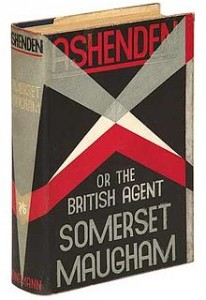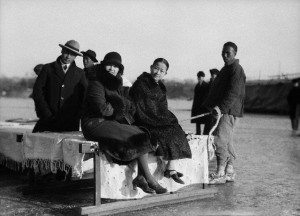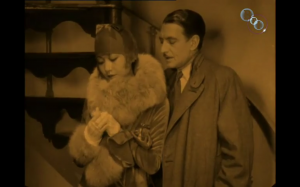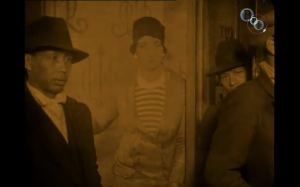Posted: July 5th, 2012 | No Comments »
Talking of strange references between China and elsewhere, invariably England but not exclusively, here’s a corker from the Reverend G Smith who produced a volume in 1847 entitled A narrative of an exploratory visit to each of the consular cities of China, and to the islands of Hong Kong and Chusan, on behalf of the Church Missionary Society, in the years 1844, 1845, 1846. Long winded? the Rev Smith – never!! And on his trip he observed that Shanghai was a second Liverpool (well, actually not that odd and with good reasoning so not included) but the poor Fujianese being compared to the Irish – I say “poor” on the grounds that I’m thinking the Rev didn’t have that great an opinion of the Irish. And so he declared of Shanghai:
 “Shanghai is a second Liverpool, in the extent of its commerce and in the various races of people attracted thither by gain. Whole streets are tenanted by the men of Fokeen [Fujian] – the Irishmen of china – men of ardent, impetuous, and enterprising minds, but turbulent and irascible withal.â€
Smith is actually one of the more interesting of that odd breed, the missionary. He did learn Chinese well enough to sermonise in the language and travelled extensively in China and forged a strong base in Hong Kong. Later in Japan, India and Australia he worked among the migrant Chinese communities in those countries.

Posted: July 5th, 2012 | 1 Comment »
At the end of last year I did a post about Shanghai in popular culture and how any reference to old Shanghai was a way of indicating extreme dodginess in a character in a novel or on TV. The classic example, which continues regularly, is, of course, that old tart Wallis Simpson and her Shanghai days (all that talk of the “Shanghai Grip” etc etc) but others abound, often in fiction, as a way of indicating suspicion and a bad and/or murky past. Last year ITV’s Marple changed an Agatha Christie Plot (Why Didn’t They Ask Evans?) to include a suspect having a dodgy Shanghai past while the author Elizabeth Wilson has done it twice now – once for a man and once for a woman, both with dodgy Shanghai pasts (in her novels War Damage and The Girl in Berlin respectively).
But it seems this tendency to use Shanghai to indicate previous dodginess goes back much further. Recently I have had (the very pleasurable) occasion to reread W. Somerset Maugham’s series of World War One spy stories Ashenden: Or the British Agent – superb stuff published in 1928 and based on Maugham’s own experiences during WW1 in Switzerland as an agent of British Intelligence. It’s basically the book that everyone who writes great spy books ever since has cited – Ambler, Le Carre, Furst…
In one story our hero Ashenden is sent to unmask a British subject spying for the Germans!! Maugham lists the villainous past offenses of the man – one Grantley Caypor – to let you know how thoroughly bad he is and that condemn him as a thorough cad:
1) born in Birmingham;
2) married a German woman;
3) became a journalist;
4) went to Shanghai where, “he got into trouble for attempting to get money on false pretenses and was sentenced to a short term of imprisonment.”;
5) and so naturally, with all those blots on his past he became a traitor and a spy for the German High Command while Our Boys fought gallantly in the trenches of France!!
Oh yes, Shanghai’s dodgy foreigners are not a new phenomenon!!

Posted: July 4th, 2012 | No Comments »
ROYAL ASIATIC SOCIETY LECTURE SERIES 2011-2012
ADDITIONAL LECTURE
The Haunted Last Days of Old China Lecture by Paul French author of Midnight in Peking

‘The Haunted Last Days of Old China’ will take us back to Peking in 1937 when Japanese troops, having already moved into Manchuria, were poised to move on Peking. In the city two groups of foreigners were brought into collision as they waited nervously for the axe to fall; the upright residents of the foreign legations and the foreigners who lived just under the radar in the city’s infamous ‘Badlands’.
Through the years of research for his latest book, Midnight in Peking, Paul French discovered that those two Worlds of Peking were not as separate or as different as people might have liked to think. His lecture will reveal a city full of intrigue, a city where the authorities were more interested in saving face than solving crimes, a city on the brink of invasion, and in doing will bring the last days of old Peking to life. French will also talk about the difficulties and complexities of recovering the stories and narratives of the foreign underworld and criminal classes in Peking and China’s treaty ports as well as the largely overlooked role of the foreign police and diplomatic presence in attempting to monitor and control their more criminally minded nationals in China. He will go on to examine the relationships between Chinese and foreigners both within law enforcement, the judiciary, the nightlife and entertainment economy and illegal activities during the late 1930s and the early years of the Japanese occupation of Peking.
Friday 6th July 2012 at 6.30pm
Followed by a Q & A and a drinks reception
Admission free, all welcome Royal Asiatic Society, 14 Stephenson Way, London, NW1 2HD
Tube: Euston, Euston Square, Warren Street
 Contact: 0207 3884539 or info@royalasiaticsociety.org
Posted: July 3rd, 2012 | No Comments »
Terrific picture here 1926 of extremely fashionable, and presumably quite wealthy and westernised, Chinese on a sled ferry in Peking….

Posted: July 3rd, 2012 | No Comments »
Not often I get put right next to James Joyce!! But I am in this Penguin podcast which includes me on Midnight in Peking, Greg Baxter’s new novel and an extract from the new issue of Mr Joyce’s Dubliners. Click here.

Posted: July 2nd, 2012 | No Comments »
I had cause to watch, once again, the fabulous 1928 silent movie Piccadilly the other day. London kitchen char turned cabaret dancer Shosho (Anna May Wong) takes London by storm in its coolest West End nightclub – breaking hearts English and Chinese. The film is amazing on so many levels – and a bit problematic now and again too given the times. However, the nightclub is wonderful and Anna May Wong’s costumes, particularly her coat are fantastic. In one scene she heads down to Limehouse to take her new West End boyfriend “slumming it” in London’s Chinese district with its marvellous multi-racial cast of characters who dance and drink the night away. It’s simply one of the best moments on film, scripted by the novelist Arnold Bennett. You can watch the whole clip here on Youtube where the coolest black guy in the East End gets in trouble for dancing with a rather pushy working girl amidst the multiracial goings on! Here’s some stills:

Shosho (Anna May Wong is unbelievably cool coat) picks up posh bloke in West End and takes him for night in her East End!

Limehouse – our Piccadilly….

Drinks all round…he downs in one while she just sips (damn that trick gets me every time!)

the dancefloor is packed and multiracial down Limehouse way

Here’s comes a working girl – note the Chinese Limehouse dudes having a Friday night pint!
Posted: July 2nd, 2012 | No Comments »
After considering the latest outcry about demolition of relics and history in China from a senior official yesterday I admit that it’s taken me a while to catch up on this sad and sorry story concerns the building from which Chiang Kai-shek led China during World War Two in Chungking (Chongqing) as shown below – it is now rubble thanks to a property developer as this article and series of photos in Caixin shows. The house survived repeated Japanese bombing attempts but couldn’t survive the property developers!

I was reminded of this house when discussing the Carl Crow War Diaries I edited a few years back with some people in New York recently – this was Crow’s impression of the Chiang compound when he visited:
Chiang Kai-Shek’s Residence, Chungking, Tuesday, June 13th 1939
My engagement with Madame Chiang Kai-shek was for 6 o’clock and was purely informal as I was going to have tea with her with no one else present except Holly Tong (effectively her secretary at the time). The Generalissimo might drop in but that was not certain as he has a big military conference on. I was waiting in the Central Publicity office after the regular military briefing when the news came that 27 planes had left Hankow and were on their way to Chungking. They were due to arrive about 5:45. I couldn’t help thinking what a swell story it would make if the danger signal came while I was calling on the Chiangs, and possibly spent an hour or so in the dugout with them. That appeared very probable for we started for their residence at about 5:30. It is not in any sense a hide out, but is prominently located and without the least attempt at camouflage. Unless their espionage system has fallen down, the Japanese must know exactly where it is. But they are so used to deception that I suppose it would never occur to them to believe that the Generalissimo would live where he is supposed to live.
There were plenty of sentries around the place, but unobtrusive. There was no show of pomp or military force. We didn’t pass more than a dozen sentries from the time we left the car and there were none inside the house.
The house was about the same as the house of a well-to-do Chinese in Shanghai. There was nothing ornate about it like the houses of the Shanghai millionaires. From an unimpressive hall we entered directly into the large reception room, which is also the drawing room. The high ceilings were marked by a modernistic glass enclosed lighting system. There were a number of fine old Chinese scrolls on the walls – monotones of floral designs, a landscape or two and one figure. There were plenty of chairs in the room – enough to seat 20 or 30 people.


Posted: July 2nd, 2012 | No Comments »
Thanks to Lu Yongxiang, vice chairman of the National People’s Congress Standing Committee, the great China protecting relics debate is back as it does every few years. It’s a familiar story – much hand wringing ensues, strong words are spoken, examples of tomb raiding and theft handed out, the existing Law on the Protection of Cultural Relics reiterated. And then….nothing….little enforcement and the debate moves on to something else. Of course the debate also usually only deals with ancient relics and leaves out any discussion of anything later or anything that might get in the way of property developers! However, Lu has specifically mentioned both rapacious property developers and lack of enforcement as two reasons why the 1982 law is looking a little impotent right now.
And if you think I’m always a bit hard on property developers, remember this is a senior Communist talking:
“A five-year census of the country’s fixed cultural heritage found several months ago that construction projects were responsible for more than half of 40,000-plus fixed cultural relics, including those located underground and underwater, “disappearing” over the past 30 years.”
The whole article here












